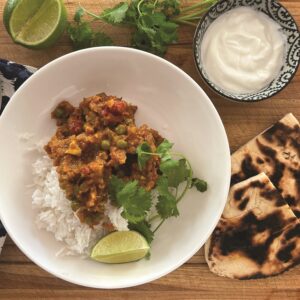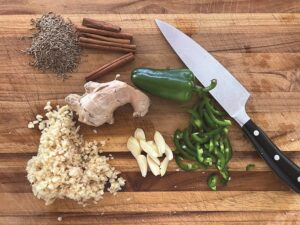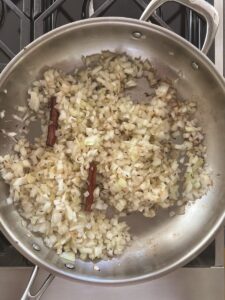I know it’s a mistake to leave the Outer Cape in September or October, missing the glorious weather we wait for all summer long. But Christopher had a work trip. So, I comforted myself with visions of London’s curry shops.
There is something about the richness and depth of curry braises that puts me in mind of the food I grew up with in south Louisiana. When New Orleans chef Arvinder Vilkhu put curried crab and shrimp gumbo on the menu at Saffron on Magazine Street, I almost wept.

Before our departure, I consulted with everyone I could think of about their current favorites. Recommendations poured in: Indie summer fellow Georgia Hall, who is from London, directed us to the Tooting Bec and Hackney neighborhoods. Another friend sent us to Brick Lane. On our second night in London, we settled into the bar at Dishoom, a restaurant one British friend said we should not miss.
While waiting for our table with Indian gimlets (gin, lime, celery bitters, and dill), we struck up a conversation with Vijay, a 30-something visitor from Las Vegas who is originally from Mussoorie, a north Indian town in the foothills of the Himalayas. He had dined at Dishoom the previous evening, he told us, and had to come back.
Vijay mentioned that Dishoom follows in the tradition of the Irani cafés of Mumbai, established by Zoroastrian refugees from Persia in the 19th century, when the city was still called Bombay and the Persian empire (now Iran) and the Indian subcontinent shared a border.
We were called to our table and soon gleefully ordering black dal, okra fries, chilli skewers, gunpowder potatoes, ruby chicken, and a plate of steaming garlic naan directly from the oven. We understood why Vijay had returned.

We’re home now, and I’m still thinking about the food — and the refugees who had created this distinctive Persian-inflected version of Indian cuisine. I learned through a little research that the Irani cafés were celebrated for offering a countercultural experience in Mumbai’s notoriously stratified society by serving people regardless of culture, class, or religion. In their heyday, until the 1950s, the cafés were wildly popular. Dishoom is a reminder of the way a group of immigrants enriched Indian society, not just with their food but with their values.
I’m aware that I know next to nothing about the complexities of this history and that I risk romanticizing it, but, in the context of our own country, where immigrants and refugees are often demonized, I can’t help but wonder about all that we are turning away at our borders. What cultural and economic losses do we accept by our refusal to create a humane and functioning immigration system?
Because we were traveling light, I resisted the urge to buy the Dishoom Cookery Book when we were at the restaurant. But as the nights turn just a little chilly, I find myself wishing I had. Meera Sodha’s Made in India, a cookbook I picked up at the big Wellfleet library book sale, turns out to be a good stand-in.
Sodha’s food, like that at Dishoom, combines cultural traditions. Sodha is a British cook who writes about the comfort food her Ugandan-Indian mother made for her when she was growing up in Lincolnshire, a rural county on England’s east coast. The curry in the recipe here is thick and deeply satisfying, perfumed with plenty of garlic and ginger plus cinnamon, cumin, and turmeric.

I’ve changed it a bit, using tomatoes instead of sauce for texture, adding vegetables, increasing the cayenne just a little, and replacing Sodha’s nut garnish with cilantro for its fresh flavor. Sometimes I make it with crisped tofu instead of chicken. If I have time, I clarify the butter for the sauteed aromatics — it won’t burn as easily as butter. But ordinary butter works fine as long as you don’t get the pan too hot.
Sodha serves the curry with naan, a simple yeasted bread cooked on a hot griddle (or just a large skillet). Rebecca Orchant’s recipe is my go-to, published in the Independent in February 2022 with her story about cooking to satisfy, at least for a while, a desire to “be somewhere new, see something for the first time, and eat something different.”
Both dishes are simple to make, and the ingredients are readily available — even back home in Truro.
CHICKEN CURRY WITH VEGETABLES
4 servings
2 Tbsp. unsalted butter or ghee (clarified butter)
1 Tbsp. canola or other neutral oil
1 tsp. cumin seeds
2 cinnamon sticks (2-3 inches long)
2 large white or yellow onions, peeled and chopped fine
1 2½-inch piece of ginger, peeled and minced
6 cloves of garlic, peeled and minced
2 jalapeño peppers, stemmed, seeded, and cut in half-rounds
Kosher salt to taste
1 cup canned tomatoes, diced
2 Tbsp. tomato paste
1½ tsp. ground cumin
½ tsp. ground turmeric
3 Tbsp. whole milk yogurt, plus more for serving
1¾ to 2 pounds skinless, boneless chicken thighs, cut into 1-inch chunks
½ pound green beans, trimmed and cut into 2-inch pieces
1 cup fresh or frozen peas
1 tsp. garam masala
Large pinch ground cayenne pepper, or to taste
Chopped cilantro and lime wedges for garnish
- Melt the butter or ghee in the oil in a large Dutch oven set over medium heat, and when it is hot and shimmering, add the cumin seeds and cinnamon sticks. Cook for a minute or two, stirring often, to intensify their flavors, then add the chopped onions. Cook, stirring occasionally, until they are golden, about 15 to 20 minutes.
- Make a paste of the ginger, garlic, and peppers by whirling them, plus a big pinch of salt, in a mini food processor. Or use a mortar and pestle or a cutting board and the side of a large chef’s knife to mince and mash these ingredients into an aromatic paste.
- Add the paste to the onions and cook for about 2 minutes, then stir in the diced tomatoes with their juices. Cook for an additional 2 to 3 minutes, then stir in the tomato paste, ground cumin, ground turmeric, and another pinch of salt.
- Slowly add the yogurt to the mixture, whisking it into the sauce with a wooden spoon. The curry may be quite thick; you can add a little water to loosen it to the consistency you like. When it begins to bubble, add the chicken and the green beans, peas, and any other vegetables. Lower the heat, put the lid on the Dutch oven, and allow the curry to cook gently for 30 minutes or so, or until the chicken is cooked through.
- Add the garam masala, along with a pinch of cayenne, and cook for 5 minutes more or so. Taste for seasoning and adjust as needed. Serve with naan or rice and additional yogurt on the side. Garnish with chopped cilantro and wedges of lime.
